Have you ever wondered about Woodpeckers in Wisconsin? Or perhaps you’re curious about the different woodpecker species that inhabit Wisconsin? Look no further! In this comprehensive guide, we will take you on a journey through the enchanting world of woodpeckers in Wisconsin. With stunning photos and detailed descriptions, you’ll learn how to identify the nine different woodpecker species that call this beautiful state home.
From the charming Downy Woodpecker to the striking Red-headed Woodpecker, each species has its own unique characteristics and habits. Discover where these woodpeckers can be found, their preferred habitats, and the best time of year to spot them.
So, are you ready to become a woodpecker expert? Let’s dive in and unravel the secrets of these fascinating birds that fill Wisconsin’s forests with their distinctive calls and vibrant plumage.
Here are the main points:
- Learn how to identify the nine woodpecker species in Wisconsin.
- Discover the unique characteristics and behaviors of each species.
- Find out where and when to spot these beautiful birds.
- Explore the conservation concerns surrounding some woodpecker species in Wisconsin.
- Enhance your knowledge and appreciation of Wisconsin’s diverse woodpecker population.
1. Downy Woodpecker
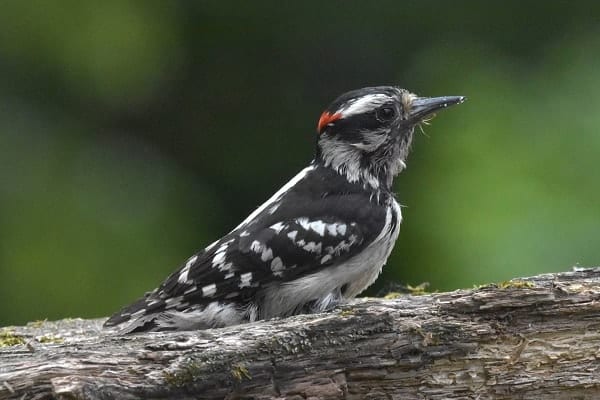
The Downy Woodpecker is one of the most common woodpeckers in Wisconsin. With its small size and distinctive black-and-white plumage, it is easily recognizable. This charming bird is known for its drumming sound, created by pecking on trees to communicate with mates and establish territory.
The Downy Woodpecker is often found in wooded areas, including forests, parks, and suburban backyards. It can be seen hopping along tree trunks and branches in search of insects and larvae. This species has a varied diet, consisting of ants, beetles, and other small invertebrates. It also enjoys feeding on berries and seeds, especially during the winter months when insect activity is reduced.
Despite its small size, the Downy Woodpecker is a skillful acrobat, able to cling to vertical surfaces and move in all directions. It has a stiff tail, which acts as a prop for balance, and strong feet with sharp claws for gripping bark.
The male and female Downy Woodpeckers have similar appearances, with the main distinguishing factor being a small red patch on the back of the male’s head. Juvenile Downy Woodpeckers have a similar plumage to adults, but their red patch is less distinct.
The Downy Woodpecker is a permanent resident in Wisconsin, meaning it does not migrate and can be observed year-round. It is a fascinating and delightful bird to observe, adding life and vibrancy to the natural surroundings.
2. Hairy Woodpecker

The Hairy Woodpecker, a close relative of the Downy Woodpecker, is a fascinating woodpecker species that can be found in Wisconsin. With their similar physical characteristics, these two woodpeckers are often confused, but there are key differences that can help you identify the Hairy Woodpecker.
The Hairy Woodpecker is slightly larger than the Downy Woodpecker, measuring about 7-10 inches in length. It has a black and white plumage with a white undersurface and a black-and-white striped back. The males also have a small red patch on the back of their heads, which is less prominent compared to the larger red patch found on the Red-headed Woodpecker.
To tell the Hairy Woodpecker apart from the Downy Woodpecker, pay attention to their bills. The Hairy Woodpecker has a longer bill, about the same length as its head, while the Downy Woodpecker’s bill is shorter in proportion to its head size.
When it comes to their habitat, the Hairy Woodpecker prefers mature forests, wooded parks, and suburban areas with a mix of trees. They are often spotted foraging for insects and larvae on tree trunks, just like other woodpecker species. Their drumming sounds can also be heard as they communicate and establish their territories.
So, the next time you spot a black-and-white woodpecker in Wisconsin, pay attention to its size and bill length to determine if it’s a Hairy Woodpecker. These fascinating birds are a joy to observe and add to the rich avian diversity in Wisconsin’s woodlands.
3. Red-headed Woodpeckers
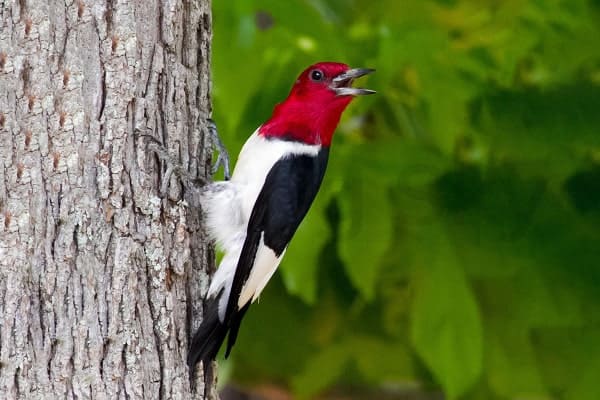
The Red-headed Woodpecker is a stunning bird that can be found in Wisconsin. With its vibrant red head and striking black-and-white plumage, it is quite a sight to behold. This woodpecker species is known for its unique behaviors and has become a conservation concern in the state.
“The Red-headed Woodpecker is a true beauty in the woodpecker family. Its bold colors and distinctive markings make it easily recognizable.”
These woodpeckers are known for their acrobatic flight patterns and can often be spotted flying from tree to tree in search of food. They have a varied diet, consisting of insects, fruits, nuts, and even small vertebrates.
Unfortunately, the Red-headed Woodpecker population has been declining in recent years, primarily due to habitat loss and the loss of dead trees that they rely on for nesting. Conservation efforts are underway to protect their habitats and raise awareness about the importance of preserving these woodpeckers.
Identification and Habitat
The Red-headed Woodpecker is about 7-9 inches in length and has a wingspan of 16-17 inches. It has a distinctive red head, white underparts, and a black back and wings. Its habitat consists of open woodlands, forests, and woodland edges.
These woodpeckers are cavity nesters and will excavate nesting cavities in dead or dying trees. They are also known for storing food by wedging it into crevices in trees, a behavior called “caching”.
Conservation Concerns
The Red-headed Woodpecker is listed as a species of conservation concern in Wisconsin due to the decline in its population. Loss of suitable habitat, loss of nesting sites, and competition for nesting cavities from invasive species are some of the major threats faced by these woodpeckers.
Conservation efforts focus on protecting and restoring suitable habitat, creating artificial nesting cavities, and controlling invasive species. It is important to raise awareness among the public about the ecological role of Red-headed Woodpeckers and the need to conserve their habitats.
4. Pileated Woodpeckers
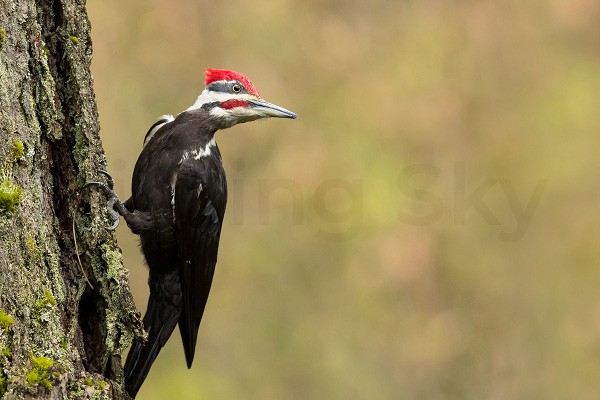
Pileated Woodpeckers
The Pileated Woodpecker, known for its impressive size, is the largest woodpecker species in Wisconsin. With its striking appearance and distinctive call, this magnificent bird is a sight to behold in the mature forests of Wisconsin.
When trying to spot a Pileated Woodpecker, keep an eye out for its black body with white stripes on the neck and wings, and a prominent red crest on its head. The males have a red mustache, while the females have a black one.
This woodpecker’s preferred habitat is large, mature forests with a mix of deciduous and coniferous trees. Look for dead or decaying trees, as Pileated Woodpeckers excavate large rectangular holes, called cavities, in these trees for nesting and foraging.
While searching for food, Pileated Woodpeckers rely on their strong bills to chip away at tree bark and search for ants, beetles, and other insects. They may also feed on fruits, nuts, and berries.
One of the most unique characteristics of the Pileated Woodpecker is its call. Described as a loud, rhythmic drumming, it can be heard from a distance and is often used for territorial communication.
“The sound of a Pileated Woodpecker’s call echoing through the forest is truly awe-inspiring. It’s a testament to the power and beauty of nature.”
If you’re lucky enough to encounter a Pileated Woodpecker, take a moment to observe its behavior. Watch as it effortlessly climbs up tree trunks and vigorously excavates cavities. Remember to maintain a respectful distance and avoid disturbing their natural habitat.
Did You Know?
Pileated Woodpeckers play a vital role in forest ecosystems. By creating cavities in trees, they provide nesting sites for other bird species and create shelter for small mammals. Additionally, their foraging activities help control insect populations, contributing to the overall health of the forest.
| Common Name | Scientific Name | Size | Habitat |
|---|---|---|---|
| Pileated Woodpecker | Dryocopus pileatus | 16-19 inches | Mature forests with deciduous and coniferous trees |
5. Yellow-bellied Sapsuckers
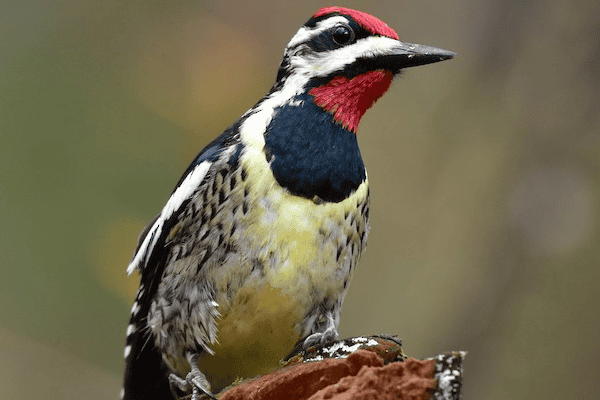
If you’re a bird enthusiast in Wisconsin, you may be familiar with the Yellow-bellied Sapsucker. This migratory woodpecker adds a splash of color to the state’s woodlands during the spring and fall seasons. But what sets this species apart from other woodpeckers in Wisconsin? Let’s dive into the unique characteristics and fascinating habits of the Yellow-bellied Sapsucker.
Distinctive Plumage
One of the most striking features of the Yellow-bellied Sapsucker is its distinctive plumage. With its black-and-white barred back and wings, it stands out among its fellow woodpeckers. The males have a red crown, which adds a vibrant touch to their appearance. However, both males and females have a yellow belly, after which they are named. These beautiful markings make the Yellow-bellied Sapsucker a true delight to spot in the trees.
Feeding Habits and Impact
The Yellow-bellied Sapsucker is known for its unique feeding strategy. Unlike other woodpeckers that primarily rely on insects, this species has a taste for the sweet sap found in trees. It drills a series of evenly spaced holes in the bark, forming neat rows called sap wells. These sap wells not only provide the Sapsuckers with nourishment but also attract insects and hummingbirds who also enjoy the sap. Thus, they play a crucial role in ecosystem dynamics, benefiting a wide range of species.
But the Yellow-bellied Sapsucker’s feeding habits can also have an impact on trees. Over time, repeated sap well drilling can weaken the trees and make them more susceptible to disease and infestation. However, this impact is typically not severe, and healthy trees can withstand the occasional Sapsucker activity.
Telltale Signs
If you’re looking to confirm the presence of Yellow-bellied Sapsuckers in your area, keep an eye out for some telltale signs. Look for rows of small, consistent holes in tree trunks or branches, arranged in a grid-like pattern. The sap wells may be stained with sap, and there may be an accumulation of wood chips and bark below the drilling site. These signs are a clear indication that Yellow-bellied Sapsuckers have been actively feeding in the area.
| Features | Description |
|---|---|
| Size | Approximately 7-8 inches in length |
| Coloration | Black-and-white barred back and wings, yellow belly in males and females, red crown in males |
| Habitat | Deciduous forests, mixed woodlands, and sometimes suburban areas with suitable trees |
| Range | Migratory in Wisconsin, seen during spring and fall; breeds in northeastern North America |
| Feeding | Drills sap wells in trees to feed on sap and insects attracted to the sap; also consumes berries and fruits |
| Sounds | Distinctive, cat-like mewing call |
As you explore the woodlands of Wisconsin, keep your eyes and ears open for the Yellow-bellied Sapsucker’s remarkable presence. With its unique plumage, feeding habits, and telltale signs, it’s an intriguing woodpecker to observe. Plus, witnessing the vital role these birds play in the ecosystem is a true testament to the wonder of nature.
6. Red-bellied Woodpeckers
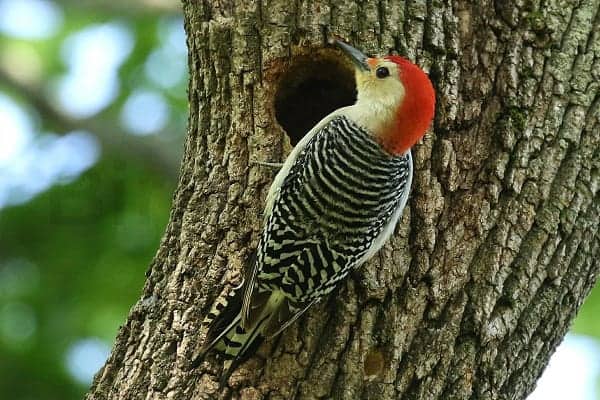
Despite its name, the Red-bellied Woodpeckers in Wisconsin with red belly is often difficult to spot. This medium-sized woodpecker species is known for its striking appearance and unique behaviors.
The Red-bellied Woodpecker has a bold black-and-white striped pattern on its back, along with a red crown and nape. Males also have a red patch on the back of their head. However, the red plumage on their belly is often hidden and not as prominent as their other markings.
These woodpeckers can be found in a variety of wooded habitats, including forests, woodlots, parks, and suburban areas. They are particularly fond of oak trees and dead snags, which they use for foraging and nesting.
The diet of Red-bellied Woodpeckers consists mainly of insects, fruits, nuts, and seeds. They have a long, barbed tongue that helps them extract insects from crevices in tree bark. They are also known to store food in tree crevices for later consumption.
One interesting behavior of these woodpeckers is their habit of drumming on resonant objects to communicate with other birds. The loud, repetitive drumming sound can be heard from a distance and is often used as a territorial display or to attract mates.
“The Red-bellied Woodpecker is a fascinating species to observe in the wild. Despite its elusive red belly, its distinct markings and behaviors make it a true marvel of nature.”
If you’re interested in spotting Red-bellied Woodpeckers in Wisconsin, keep an eye out for these distinctive birds in wooded areas, especially near oak trees and dead snags. With a bit of patience and a keen eye, you may be able to catch a glimpse of their unique beauty and witness their fascinating behaviors.
7. Northern Flicker

The Northern Flicker is a unique and fascinating woodpecker species found in Wisconsin. Known for its distinctive call and behavior, the Northern Flicker is a treat to observe in the wild. This migratory bird adds vibrancy to the Wisconsin landscape with its striking plumage and graceful flight.
Identifying the Northern Flicker is relatively easy, thanks to its distinctive markings and behavior. Here are some key characteristics to look out for:
- The Northern Flicker measures about 11 to 12 inches in length.
- Its plumage is characterized by a beautiful combination of brown and black, with a prominent crescent-shaped black mark on its chest.
- The undersides of its wings are bright yellow, making it particularly eye-catching in flight.
- The Northern Flicker is known for its habit of “anting,” in which it rubs ants or other insects on its body. This behavior is thought to help control parasites.
In Wisconsin, the Northern Flicker is a migratory species, arriving in the spring and staying until the fall. During this time, they can be found in a variety of habitats, including forests, woodlands, and urban areas with ample trees. Keep an eye out for their distinctive flight pattern, which involves a series of rapid wingbeats followed by a short glide.
The Northern Flicker plays an essential role in Wisconsin’s ecosystem. They feed on insects, including ants, beetles, and termites, which help control populations and maintain the balance of the natural environment.
“The Northern Flicker is a captivating woodpecker species that brings charm and beauty to the Wisconsin countryside. Its unique appearance and behavior make it a delight to spot during its migratory visits.”–Your Name, Woodpecker Enthusiast
| Characteristics | Northern Flicker |
|---|---|
| Size | 11 to 12 inches in length |
| Plumage | Brown and black with a distinct crescent-shaped black mark on the chest |
| Flight Pattern | Series of rapid wingbeats followed by a short glide |
| Habitat | Forests, woodlands, and urban areas with ample trees |
| Diet | Insects, including ants, beetles, and termites |
8. Black-backed Woodpeckers
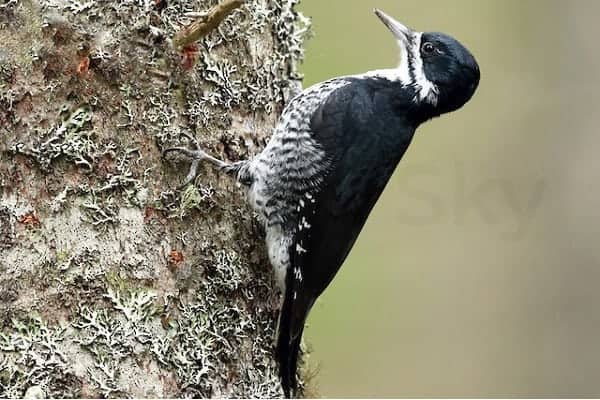
The Black-backed Woodpecker is a fascinating medium-sized woodpecker species that can be found in the beautiful forests of Wisconsin. With its striking black-and-white barred plumage, it is a visually stunning bird to behold. If you are lucky enough to spot one during your outdoor adventures, you are in for a treat!
This woodpecker species has a unique role in maintaining the health of forests. It is known for its preference for recently burned areas, where it feeds on wood-boring beetles and other insects that thrive in charred wood. By foraging in these post-fire ecosystems, Black-backed Woodpeckers contribute to the ecological balance and regeneration of the forest.
If you’re hoping to catch a glimpse of a Black-backed Woodpecker, head to areas with recent forest fires or bark beetle outbreaks. Look for them on tall, dead trees, as they excavate nest cavities and search for food in their preferred habitats. Keep your eyes and ears open for their distinctive calls and drumming sounds.
Frequently Asked Questions
Q1: What is the most common woodpecker in Wisconsin?
The Downy Woodpecker is the most common woodpecker in Wisconsin.
Q2: Do woodpeckers stay in Wisconsin in the winter?
Yes, many woodpecker species, including the Downy and Hairy Woodpeckers, stay in Wisconsin throughout the winter.
Q3: Do Wisconsin woodpeckers migrate?
Some woodpecker species in Wisconsin, like the Northern Flicker, do migrate, while others, such as the Downy Woodpecker, tend to stay year-round.
Q4: Where do pileated woodpeckers live in Wisconsin?
Pileated Woodpeckers can be found in Wisconsin’s mature forests, particularly in areas with large, older trees.
Q5: What’s the biggest woodpecker in Wisconsin?
The Pileated Woodpecker holds the title of the biggest woodpecker species in Wisconsin
